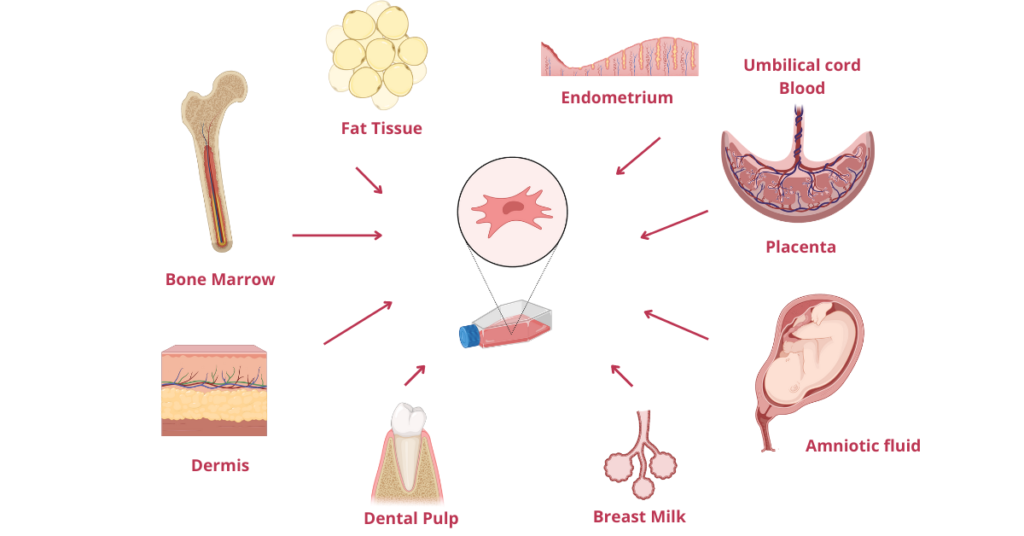The human body is made up from a large number of different cell types, many of which have specific functions, for example, blood cells, muscle cells, nerve cells, bone cells, fat cells etc. Although the structures or organs they make up seem to have permanence, many of the cells have a limited lifetime within the body and so new cells are constantly needed to replace them. If we look at our skin, for example, we can notice that over time the top (older) layer sheds, to be replaced by new cells thus restoring the integrity of the skin surface. Similarly, if the skin surface suffers a cut or wound it will heal over time, the different layers of skin structure being regenerated to create a fully functional repair
What are Stem Cells?
The ability of the body to replace and repair cells and tissues is due to the presence of Stem cells. Stem cells are present in almost every organ, including the brain, and they have the unique ability to grow and differentiate into many specialised cell types depending on their location within the body. The two unique properties that make them different from all other types of cells are: 1) self-renewal – the ability to divide in an undifferentiated state; and 2) potency – the ability to differentiate into a specialised cell.
All of our main cell types appear at the very early stages of embryonic development, and at this point embryonic stem cells have an incredible potential to divide and develop into any cell type of the human body. After birth, the stem cells lose their ability divide infinitely or become any type of cell – adult stem cells become more specialised, taking on the repair and regeneration functions in different organs and tissues.
Though embryonic stem cells are much more potent than adult stem cells, for ethical reasons (especially for human treatment applications), embryonic stem cells are not used for therapeutic purposes. Therefore, stem cell therapies have to be developed from an appropriate source of adult stem cells. Thus, it is very important to consider the source of adult stem cells when they are to be used for certain therapeutic purposes. There are two major types of adult stem cells: 1) tissue-specific, such as blood-forming stem cells in the bone marrow, and 2) stromal, or mesenchymal stem cells (MSCs), found in the connective tissue around organs such as fat or cord blood. Due to relative simplicity in collecting MSCs, they are very often the first choice for stem cell therapies. They can be obtained from a wide variety of sources including; bone marrow, peripheral blood, fat tissue, birth-associated tissues like placenta, umbilical cord and cord blood, endometrium and even dental pulp.
How can we obtain stem cells?
After the tissue of interest has been extracted (e.g., through liposuction of fat or withdrawal of peripheral blood), it is first tested for various types of extraneous matter, for example viral infections such as hepatitis, HIV, HTLV etc. to ensure that these are not passed on in the final stem cell preparation. It is then subjected to homogenization and treatment with various enzymes, centrifuged and washed with buffers prior to growing the necessary fraction to expand the MSCs. Expansion of stem cells as well as all the testing procedures are carried out in specialized certified sterile suits by trained personnel. Stem cells preparations are usually maintained in specific growth medium in an incubator that mimics physiological conditions such as temperature (37o C ) and CO2 (5%) in a humidified atmosphere. Adherence to plastic is one characteristic feature of MSCs, so after several days cells that do not attach to the surface of the chamber in which they are grown are removed and the remaining adherent cells can be further tested in order to check their quality and characteristics.

Quality control
Before stem cells preparations can be used for therapeutic purposes, they must undergo quality control testing to ensure that they are sufficiently safe (free of any possible infections from viruses and fungi) and retain the intended potency for their application. i.e., be able to differentiate into specific cell type, and appropriate growth and metabolic rate. MSCs are also tested by a specialized technique (flow cytometry analysis) for the certain cell surface markers in order to confirm their status and suitability for stem cell therapy.
Administration of stem cells
Stem cells can be administered in various ways, including direct injection to target a problem area, such as injection into a joint, or by intravenous injection or injection into the spinal canal. Stem cells are also widely used for “anti-ageing” purposes; in this case they are injected under or into the skin. Stem cells can also be differentiated and grown into specific organs prior transplantation such as pancreatic islets that have potential to restore insulin production.
